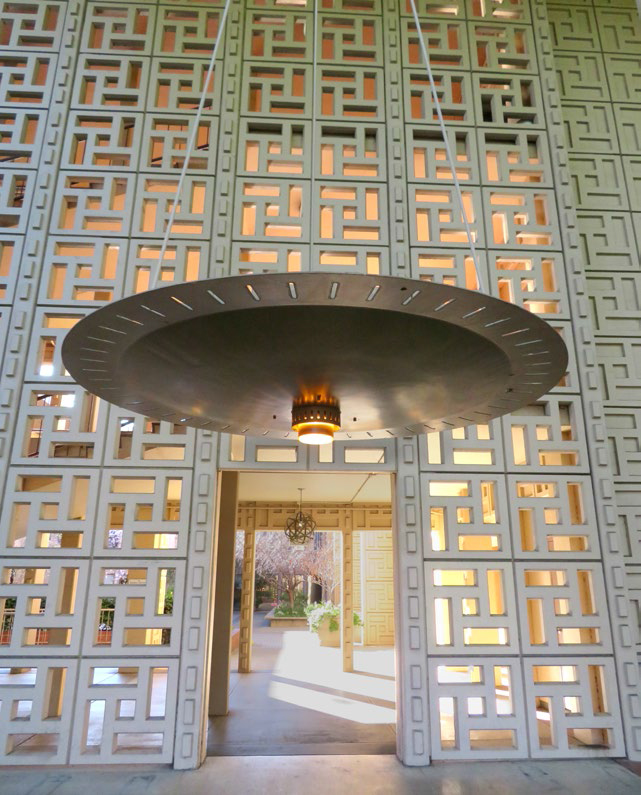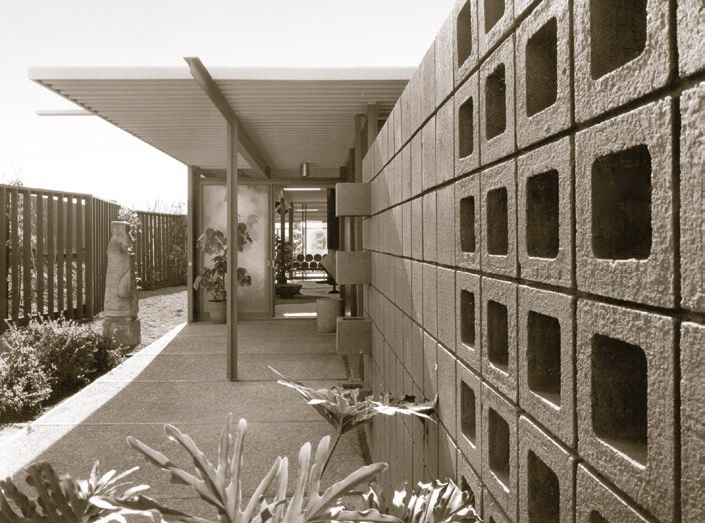Blocks of Beauty - Page 3
 |
|
|
 |
|
|
 |
 |
 |
|
|
Another architect from the United States who used screen and shadow blocks in a big way was Joseph Allen Stein, who moved to India from the Bay Area in 1955.
His use of both concrete and metal screens as cladding for buildings evoked the traditional Indian jali, a latticed screen, evoking what Stephen White (in his book Building in the Garden: the Architecture of Joseph Allen Stein) said was "luminous shade, filtered light, and a sense of enclosure without total separation from the outdoor spaces."
But it was Stone who brought the screen block, and other patterned blocks, to the fore.
For the embassy, Stone had his ornamental blocks hand-built on site. He even patented some of his screen block patterns, but never sued to stop others from using them.
It didn't take long for the mass market to adopt the idea. Soon Stone's block designs, and many others, were being churned out and used throughout the U.S.—and beyond.
"It was inevitable," Stone wrote, "that such a simple, inexpensive, and practical device would immediately become part of the building vocabulary and would have wide and indiscriminate usage."
Stone used decorative block to face many projects, including the Stanford Medical Center, Palo Alto's Rinconada Library, the Community Hospital of the Monterey Peninsula, and the Huntington Hartford Museum in Manhattan.
Screen blocks gained wide popularity starting in 1957, Ron Marshall says, as the embassy became known. But they had begun appearing two years earlier.
"Something brand new in concrete blocks is now being introduced to the building public," Florence Schmidt wrote in August 1955 in the Los Angeles Times. "It is a distinctive block that combines structural value and décor within a single unit."
The blocks she described were of various colors and various patterns of screen, "making possible unlimited decorative possibilities."
"A building material long valued for its structural qualities—concrete block—is winning increasing recognition for its ability to fulfill a decorative role in construction as well," Glenn Fowler told readers of the New York Times in August 1962, adding, "…because it comes in a wide variety of sizes, colors, textures, and shapes, it can be used in many decorative ways."
Among architects who picked up on concrete blocks were the Bay Area modernist Gardner Dailey, who used screen block on buildings on the UC Berkeley campus; and Minoru Yamasaki, who used screen block—where else?—on the headquarters of the American Concrete Institute in Detroit.
Ed Fickett, the Los Angeles architect known for his stylish custom and tract mid-century modern homes, loved to create intricate patterns of light and shade using a variety of materials, including wooden screens and louvers. He also used shadow and screen blocks on some of his custom and tract homes to nice effect.
Joe Eichler, who developed 11,000 mid-century modern homes, was apparently not a fan of decorative concrete block, though he used standard blocks often enough for walls. Eichler's X-100, the experimental all-steel house in San Mateo Highlands designed by Jones & Emmons, was one of his few homes that used decorative block, accented with projecting shadow catchers and screen blocks at its entryway and street-facing courtyard.
Eichler's original architects, Anshen and Allen, loved adding texture and décor to their buildings, in the manner of Wright, including with decorative block. Their Mechanics Bank in Richmond, California, seems a tribute to Wright's textile-block houses, with a frieze of Wrightian patterned blocks, probably of their own design.
When it comes to tract housing, though, no one beat Bill Krisel, who with partner Dan Palmer filled neighborhood after neighborhood in Palm Springs with screen block walls alongside his distinctive low-slung homes. Krisel called the blocks "functional ornamentation."
"We did such a volume that we could design our own building material," Krisel said in a 2012 interview. "All the shadow block, pierced [screen] block, we designed those and had the concrete block people make them. When you build 500 houses and can use those, the guy says, 'Tell us what you want, and we can make them for you.'"




